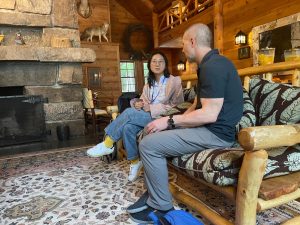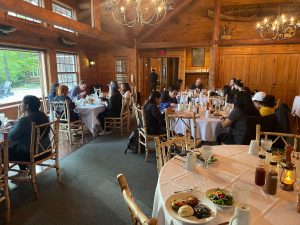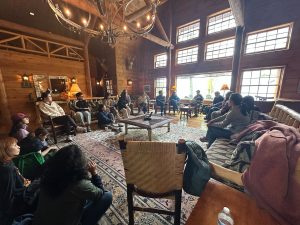 “It’s great to be in a place where cell phone coverage is pretty bad,” joked Josh Introne, associate professor at the iSchool and one of the organizers of this year’s Consortium for the Science of Sociotechnical Systems (CSST) Summer Institute, which took place May 28 to June 2. Tucked away at Syracuse University’s Minnowbrook Conference Center in the Adirondacks, the diverse gathering of 30 scholars embraced the calm—and the opportunity for conversations that were as much about research as they were about building relationships.
“It’s great to be in a place where cell phone coverage is pretty bad,” joked Josh Introne, associate professor at the iSchool and one of the organizers of this year’s Consortium for the Science of Sociotechnical Systems (CSST) Summer Institute, which took place May 28 to June 2. Tucked away at Syracuse University’s Minnowbrook Conference Center in the Adirondacks, the diverse gathering of 30 scholars embraced the calm—and the opportunity for conversations that were as much about research as they were about building relationships.
Since 2008, the annual meeting, which rotates among institutions and locations, has brought together junior and senior scholars working in sociotechnical systems (STS)—a perspective that examines how society and technology continually shape one another. It draws participants from fields as varied as computer science, information systems, sociology, anthropology, and human-computer interaction.
This year’s event in the Adirondacks “was the perfect place to continue a decades-long push to create community among scholars that don’t quite fit into one disciplinary space, but all of whom share a commitment to understanding how technology impacts society,” said Ingrid Erickson, associate professor and Introne’s co-organizer.
At its heart, the institute is designed to nurture the next generation of STS scholars. “Our goal is to help Ph.D. students and newly christened academics find some of their people out there in the world,” Erickson explained. To that end, she and Introne worked hard to build small groups from among 21 emerging researchers and seven established mentors. “It was exciting to pair people in my mind and then see those social clusters actually thrive and excel in reality.”
That personal connection was especially valuable for student organizer LaRoyce Covington, a Ph.D. student in Introne’s lab who studies collective intelligence in complex adaptive systems. “Going in, I wasn’t completely sure what CSST was about,” he admitted. “My experience was excellent, though, and I got to meet quite a few wonderful people interested in much of the same things I was.”
For Covington, that week’s career planning sessions were especially valuable. Other conference activities included peer networking, roundtable discussions of individual and group research interests, and skill-building tutorials, such as a workshop on how to manage an interdisciplinary team.
 The 2025 institute also responded directly to shifting realities in academia with several structured activities around grant-seeking. A program officer from the National Science Foundation joined the group to help participants navigate the rapidly changing federal funding landscape, while Introne assembled a set of persistent online resources they could use long after the week had ended. These included an interactive funding matrix, decision matrix and associated planning tool to help researchers strategize about how to use their work to make broader impacts. Participants were also provided with a wide range of resources compiled to help sociotechnical researchers navigate the complexity of highly interdisciplinary, multi-stakeholder teams.
The 2025 institute also responded directly to shifting realities in academia with several structured activities around grant-seeking. A program officer from the National Science Foundation joined the group to help participants navigate the rapidly changing federal funding landscape, while Introne assembled a set of persistent online resources they could use long after the week had ended. These included an interactive funding matrix, decision matrix and associated planning tool to help researchers strategize about how to use their work to make broader impacts. Participants were also provided with a wide range of resources compiled to help sociotechnical researchers navigate the complexity of highly interdisciplinary, multi-stakeholder teams.
“Of all the events I’ve been to, this was one of the warmest and most rewarding CSST summer institutes,” said Introne, whose sentiment was echoed in glowing feedback from participants. He and Erickson saw the STS scholars leave feeling reinvigorated, and they hope to keep growing these positive connections. “I think everyone is motivated to carry this forward,” Introne said.
